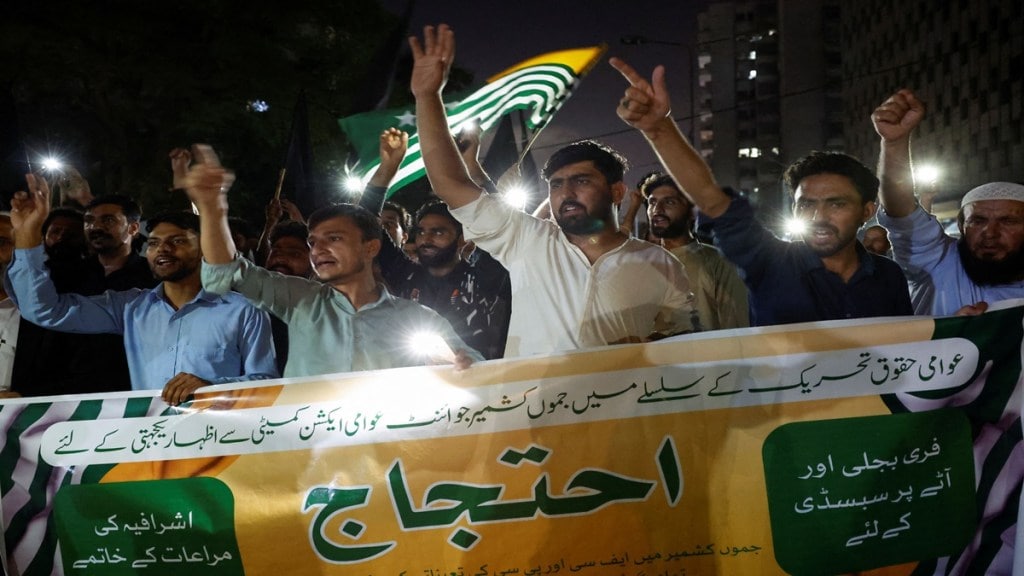Fueled by fury over soaring electricity tariffs, tax burdens, and sky-high inflation, Pakistan-occupied-Kashmir (PoK) is currently a powder keg that is ready to explode. People have taken to the streets, violently protesting these sky-rocketing bills and food prices. These protests are a depressing reminder of the long-standing violation of human rights in the area.
The protests began on May 10 and have left over 90 people injured. A massive crowd of protestors embarked on a daring march on Saturday toward Muzzaffarabad via Rawalkot. But the authorities weren’t having it. The police and army came down hard, firing tear gas and wielding batons in an attempt to stop the advancing crowd. What followed was utter chaos. The clashes escalated into a full-blown brawl as enraged protestors turned their wrath on the police, torching several security vehicles. Several videos are doing the rounds of social media depicting a similar scenario in almost all of PoK. The demonstrations, fueled by anger over soaring prices of food, fuel, and utilities, escalated on Tuesday.
The paramilitary Rangers, who were called in to maintain peace on Sunday, faced hostility as they tried to leave the area. Instead of going through Brarkot, a village bordering Khyber Pakhtunkhwa, the convoy of 19 vehicles, including five trucks, opted for a different route, exiting the region from Kohala. Stones were pelted on the vehicle as soon as it reached PoK’s capital Muzaffarabad. At least three civilians lost their lives and six others were injured as paramilitary Rangers fired shots and tear gas during protests in Muzaffarabad.
What led to violent protests in Pakistan occupied Kashmir?
Leaders and authoritarian figures in Pakistan-occupied Kashmir have been claiming that there’s unfair treatment from the government in Islamabad regarding power distribution, and they have been protesting this for a long time now. According to Dawn, the region’s top official, Chaudhry Anwarul Haq, voiced concerns about not getting their rightful portion of the 2,600MW of hydropower generated by the Neelum-Jhelum project. He also mentioned that his plea for funds to raise government employee salaries in the latest budget was turned down. As a result, he had to reallocate development funds to cover their pay. Protests were also held in Sehansa, Samahni, Mirpur, Tattapani, Hattian Bala, Rawalakot, Khuiratta – all in PoK.
On Saturday, officials in Muzaffarabad blocked roads leading to the state capital by placing piles of dirt, making it difficult for people to enter the city. As per a statement from the District Headquarters Hospital Kotli, nine injured protesters and 59 wounded policemen were taken in for medical care. Geo News stated that a total of 29 protestors were injured during the clashes, reported PTI.
Pakistan’s Tumbling Economy
According to The Indian Express, the situation became worse for Pakistan’s economy when they halted all trade in response to the constitutional alterations made by India in Jammu and Kashmir in August 2019. India-Pakistan trade has dwindled to merely $2 billion annually over the past five years, a mere fraction of the $37 billion trade potential projected by the World Bank.
Pakistan’s foreign currency reserves have taken a big hit since global food and fuel prices went up due to the Russia-Ukraine conflict. Similar money troubles hit Sri Lanka in 2022-23, but then, India had stepped in to help. According to the State Bank of Pakistan, the country’s reserves dropped from $20.1 billion in August 2021 to just $2.9 billion in February 2023, which is only enough to cover one month’s worth of imports. Pakistan gets almost 40% of its energy from imports.
Pakistan’s economy relies a lot on aid, and its private businesses aren’t very strong. The stock market hasn’t grown much either. In the fiscal year 2023, Pakistan’s GDP actually shrank by 0.17%. The International Monetary Fund (IMF) recently said Pakistan needs a lot of money—$123 billion over five years. They’re expected to ask for $21 billion in 2024-25 and $23 billion in 2025-26.
Call for Indian government’s intervention
PoK activist Amjad Ayub Mirza urged the Indian government to step in and help. He said that India must not ignore the ongoing situation in Pakistan-occupied Jammu and Kashmir. “The whole of Pakistan-occupied Jammu Kashmir has been shut down by peaceful protesters who are being beaten up and shot at by the Pakistan police, Punjab police… India now should focus all its attention on Pakistan-occupied Jammu and Kashmir and help and facilitate the independence of this occupied territory, including Gilgit-Baltistan,” Mirza told ANI. He also requested the Indian government to approach Pakistan’s ambassador and ask for an explanation.
A week ago, Defence Minister Rajnath Singh said that given the current situation in Jammu and Kashmir and its economic progress, people in PoK would naturally want to join India. He emphasized that India wouldn’t need to use forceful methods to achieve this.

